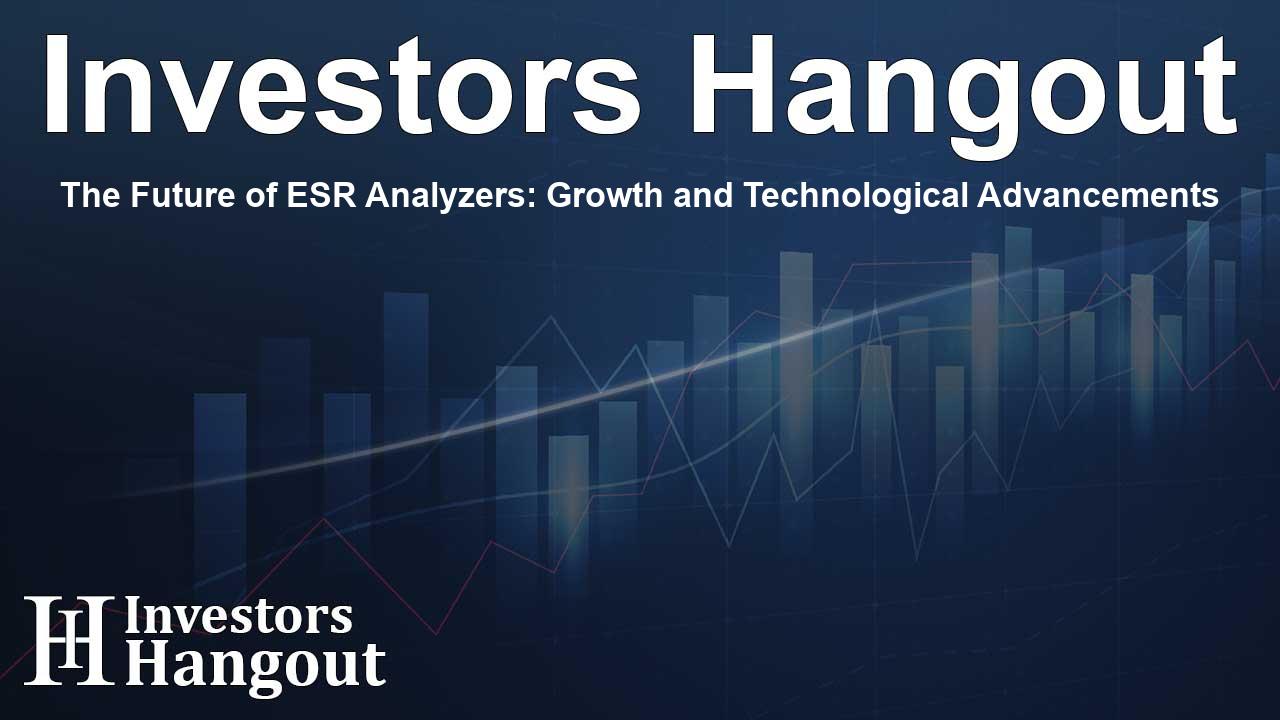The Future of ESR Analyzers: Growth and Technological Advancements

Exploring the Growth of ESR Analyzers
The global market for ESR analyzers is experiencing significant growth, projected to reach USD 115.4 million by 2035. With an anticipated compound annual growth rate (CAGR) of 4.8% from 2025 to 2035, the increased demand for accurate and automated diagnostic tools is reshaping the healthcare landscape.
This growth is primarily driven by the rising prevalence of chronic diseases and advancements in technology. Automated ESR analyzers have made strides in offering higher accuracy and efficiency, allowing healthcare professionals to improve patient care profoundly. As the demand for ESR testing rises, the industry is expected to continuously evolve.
Key Drivers Powering the ESR Analyzer Industry
The Adoption of Automation
One of the major contributors to the expansion of the ESR analyzer market is the increasing adoption of automated systems. These analyzers provide faster and more accurate results, greatly enhancing diagnostic workflows. In environments with high testing volumes, the reduced risk of human error through automation is invaluable, leading to broader use in hospitals and laboratories.
Technological Innovations
Innovations in ESR analyzer technology are also vital. New optical and sensor-based technologies streamline operations, facilitating quicker testing times. Integration with Laboratory Information Systems (LIS) and Hospital Information Systems (HIS) allows for better workflow management, a trend that is rapidly gaining traction among healthcare providers.
The Growing Demand for ESR Testing
As chronic and inflammatory diseases such as rheumatoid arthritis, tuberculosis, and autoimmune disorders become more prevalent, the need for ESR testing rises. With an aging population more susceptible to these conditions, ESR analyzers are becoming crucial diagnostic tools in managing patient health effectively.
Regional Analysis of the ESR Analyzer Market
The ESR analyzer market is expanding globally, fueled by varied regional demands. For example, countries like India show a CAGR of 5.4%, while Germany and Japan demonstrate growth rates of 4.8% and 4.5% respectively. Each region presents unique challenges and opportunities.
Market Insights and Projections
Recent statistics indicate significant market potential. By 2035, the global ESR analyzer market is expected to surpass USD 115 million. Enhanced diagnostic requirements due to chronic health conditions are driving this momentum, alongside advancements in automation that enhance test accuracy.
Challenges Facing the ESR Analyzer Market
Despite the positive outlook, the ESR analyzer market is not without challenges. High initial investments required for advanced automated systems can hinder smaller laboratories and healthcare facilities. Moreover, there is an ongoing need for trained personnel to manage sophisticated equipment, leading to an additional layer of operational complexity.
Furthermore, navigating through regulatory compliance can prove daunting, especially when introducing new technologies in varied markets. This often delays product launches and increases operational costs for manufacturers.
Competitive Landscape and Recent Developments
The ESR analyzer market comprises numerous local and international players, each striving to innovate within the space. Companies are expanding their research and development efforts, with the recent introduction of advanced automated systems reflecting this trend. For example, the launch of new control products that enhance calibration precision has attracted interest in the market.
Future Outlook and Trends
As we look ahead, the integration of IoT and AI technologies into ESR analyzers is expected to further enhance diagnostic capabilities and predictive analytics. Point-of-care testing solutions will likely continue gaining traction, offering rapid results where they are most needed.
This convergence of automation and technology in healthcare highlights a positive trajectory for the ESR analyzer market. The future holds promising advancements aimed at improving patient outcomes while reflecting the increasing demand for efficient diagnostic systems.
Frequently Asked Questions
What factors are driving the growth of the ESR analyzer market?
The growth is driven by technological advancements, increased adoption of automated systems, and rising prevalence of chronic diseases, necessitating regular ESR testing.
What role does automation play in ESR analyzers?
Automation enhances the accuracy and efficiency of ESR testing, significantly reducing human error and expediting results delivery, essential in high-volume testing environments.
How is the market for ESR analyzers segmented?
The market is divided based on product type (automated, semi-automated, manual), testing method (Westergren, Wintrobe), and end-user industry (hospitals, labs).
What challenges does the ESR analyzer market face?
Challenges include high initial investment costs, regulatory compliance requirements, limited access to healthcare infrastructure in lower-income regions, and the need for ongoing training for healthcare staff.
How are companies within the ESR analyzer market responding to competition?
Companies are focusing on research and development to innovate their product offerings and improve existing technologies to maintain a competitive edge in a highly fragmented market.
About Investors Hangout
Investors Hangout is a leading online stock forum for financial discussion and learning, offering a wide range of free tools and resources. It draws in traders of all levels, who exchange market knowledge, investigate trading tactics, and keep an eye on industry developments in real time. Featuring financial articles, stock message boards, quotes, charts, company profiles, and live news updates. Through cooperative learning and a wealth of informational resources, it helps users from novices creating their first portfolios to experts honing their techniques. Join Investors Hangout today: https://investorshangout.com/
Disclaimer: The content of this article is solely for general informational purposes only; it does not represent legal, financial, or investment advice. Investors Hangout does not offer financial advice; the author is not a licensed financial advisor. Consult a qualified advisor before making any financial or investment decisions based on this article. The author's interpretation of publicly available data shapes the opinions presented here; as a result, they should not be taken as advice to purchase, sell, or hold any securities mentioned or any other investments. The author does not guarantee the accuracy, completeness, or timeliness of any material, providing it "as is." Information and market conditions may change; past performance is not indicative of future outcomes. If any of the material offered here is inaccurate, please contact us for corrections.